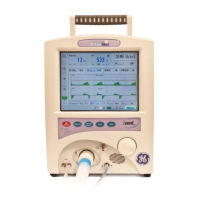138
NON-TRIGGERED BREATHS (INSPIRATORY TRIGGER FAILURE)
Detection - Failure to trigger the ventilator is detected by patient dysynchrony
with mechanical breaths. These are apparent as spontaneous efforts, on the flow
waveform, which do not result in a rise in pressure on the pressure waveform.
Intervention - Make sure that the enclosed volume of the facemask is not too
large, or that the facemask is not poorly applied (see section under excessive
leak). If the pressure trigger is greater than -0.5cmH2O, decrease the pressure
trigger level, Also ensure that flow triggering is set higher than 2 L/M, and try
decreasing this value.
EXCESSIVE TRIGGERING (AUTO CYCLING):
Detection - Auto cycling is detected by the observation of a rapid auto cycling
pattern independent of the patient's breathing pattern.
Intervention – Increase the flow trigger setting first. Then after observing the
patient and confirming the persistence of auto cycling, try increasing the
pressure trigger setting. Confirm that the facemask interface has a tight seal. If
the situation persists, consider recalibrating the unit.
I:E CYCLING DYSYNCHRONY
Detection – Delayed I:E cycling is indicated by High Pressure alarms or obvious
ventilator patient dysynchrony and breath stacking.
Intervention – Increase the percent of peak flow termination value (Esens) from
the menu. Additionally, consider decreasing I-time. An air leak can lead to
"inspiratory hang up". This can be corrected by adjusting the full facemask or if a
nasal mask is used, consider switching to a facemask. To exclude the presence of
breath stacking, briefly disconnect the patient to allow spontaneous
decompression. If the dysynchrony is resolved as a result, ensure that the
settings for I-time and percentage leak flow termination are consistent with
clinical guidelines.
Optimizing expiratory synchrony is of particular importance to patients with
obstructive ventilatory disorders. These patients generally require prolonged
expiratory periods to optimize airway emptying that minimizes breath stacking. In
these patients it is essential to titrate the end inspiratory flow threshold to
achieve good expiratory synchrony. A high flow threshold (70–90% of peak flow -
Esens) is recommended. As previously mentioned, the I-time should also be
regulated to minimize breath stacking if a lower end inspiratory threshold is
chosen.
PREMATURE I:E CYCLING
Detection – Premature I:E cycling is indicated by patient ventilator dysnchrony,
with no plateau on the pressure waveform concomitant with a negative flow
deflection.

